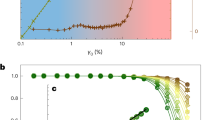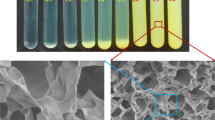Abstract
Precise a priori prediction of time required to achieve colloidal sol-gel transition is a challenging task. This is because not much system-specific theoretical work has been carried out on kinetics of colloidal gelation, where the physical bond formation is strongly affected by the surface characteristics of the colloidal particles. Under such situation, drawing analogies from apparently dissimilar phenomena that share the same physical foundation can prove helpful. Interestingly the physical processes such as the fracture dynamics in a material leading to failure, as represented by the Bailey criterion of durability, and sol-gel transition are known to satisfy the Markovian criterion, suggesting equivalent mathematical formalism. Such equivalence leads to a simple mathematical formalism given by the modified Bailey criterion which is identical in construction to the criterion in fracture dynamics. In this work, we assess the modified Bailey criterion of durability to predict the time required to attain the sol-gel transition in a colloidal dispersion under non-isothermal conditions. The model parameters are derived from the gelation experiments on colloidal clay dispersion conducted under the isothermal conditions. Interestingly, the prediction of the time to attain the sol-gel transition under non-isothermal condition from the modified Bailey criterion matches the experimental observation with remarkable accuracy, thereby validating an independent methodology to obtain vital knowledge on colloidal sol-gel transition. This work, therefore, validates the mathematical formalism of one Markovian process (fracture dynamics) by carrying out experiments on another Markovian process (sol-gel transition), which are otherwise distinctly different from each other. Such correspondence highlights the profound similarity in the microstructural changes occurring in the two distinct systems.





Similar content being viewed by others
Data availability
The datasets generated during and/or analyzed during the current study are available from the corresponding author on reasonable request.
References
Assovskii I, Istratov A (2008) Effect of the mode of combustion on the service life of the combustion chamber material. Russian Russ J Phys Chem, Focus on Physics 2:589–594. https://doi.org/10.1134/S1990793108040131
Baghdadi HA, Sardinha H, Bhatia SR (2005) Rheology and gelation kinetics in laponite dispersions containing poly (ethylene oxide). J Polym Sci B Polym Phys 43:233–240. https://doi.org/10.1002/polb.20317
Bai Y, Xiong C, Wei F, Li J, Shu Y, Liu D (2015) Gelation study on a hydrophobically associating polymer/polyethylenimine gel system for water shut-off treatment. Energy Fuel 29:447–458. https://doi.org/10.1021/ef502505k
Bailey J (1939) An attempt to correlate some tensile strength measurements on glass: III. Glass Ind 20:95
Blomberg C (2007) Stochastic processes physics of life. Elsevier Science B.V, Amsterdam, pp 178–182
Carter DR, Caler WE (1983) Cycle-dependent and time-dependent bone fracture with repeated loading. J Biomech Eng 105:166–170. https://doi.org/10.1115/1.3138401
Chen DTN, Wen Q, Janmey PA, Crocker JC, Yodh AG (2010) Rheology of soft materials. Annu Rev Condens Matter Phys 1:301–322. https://doi.org/10.1146/annurev-conmatphys-070909-104120
Cocard S, Tassin JF, Nicolai T (2000) Dynamical mechanical properties of gelling colloidal disks. J Rheol 44:585–594. https://doi.org/10.1122/1.551107
Dewapriya MAN, Rajapakse RKND (2014) Molecular Dynamics Simulations and Continuum Modeling of Temperature and Strain Rate Dependent Fracture Strength of Graphene With Vacancy Defects. J Appl Mech 81. https://doi.org/10.1115/1.4027681
Dewapriya M, Rajapakse R, Nigam N (2015) Influence of hydrogen functionalization on the fracture strength of graphene and the interfacial properties of graphene–polymer nanocomposite. Carbon 93:830–842. https://doi.org/10.1016/j.carbon.2015.05.101
Dhavale TP, Jatav S, Joshi YM (2013) Thermally activated asymmetric structural recovery in a soft glassy nano-clay suspension. Soft Matter 9:7751–7756. https://doi.org/10.1039/C3SM51378E
Ding R, Leonov AI (1996) A kinetic model for sulfur accelerated vulcanization of a natural rubber compound. J Appl Polym Sci 61:455–463. https://doi.org/10.1002/(sici)1097-4628(19960718)61:3<455::aid-app8>3.0.co;2-h
Freeds A, Leonov AI (2002) The Bailey criterion: statistical derivation and applications to interpretations of durability tests and chemical kinetics. Z angew Math Phys 53:160–166. https://doi.org/10.1007/s00033-002-8148-5
Gagniuc PA (2017) Markov chains: from theory to implementation and experimentation. John Wiley & Sons, New Jersey
Israelachvili JN (2011) Intermolecular and surfaces forces. Academic Press London
Jatav S, Joshi YM (2014) Rheological signatures of gelation and effect of shear melting on aging colloidal suspension. J Rheol 58:1535–1554. https://doi.org/10.1122/1.4887344
Jatav S, Joshi YM (2017) Phase behavior of aqueous suspension of Laponite: new insights with microscopic evidence. Langmuir 33:2370–2377. https://doi.org/10.1021/acs.langmuir.7b00151
Joshi N, Suman K, Joshi YM (2020) Rheological behavior of aqueous poly(vinyl alcohol) solution during a freeze–thaw gelation process. Macromolecules 53:3452–3463. https://doi.org/10.1021/acs.macromol.0c00488
Kampen NG (1981) Stochastic processes in physics and chemistry. North Holland Publishing Company, Amsterdam
Keshavarz B, Divoux T, Manneville S, McKinley GH (2017) Nonlinear viscoelasticity and generalized failure criterion for polymer gels. ACS Macro Lett 6:663–667. https://doi.org/10.1021/acsmacrolett.7b00213
Larson RG (1999) The structure and rheology of complex fluids. Oxford University Press
Leocmach M, Perge C, Divoux T, Manneville S (2014) Creep and fracture of a protein gel under stress. Phys Rev Lett 113:038303. https://doi.org/10.1103/PhysRevLett.113.038303
Leonov A. I, Basov N. I, V KY (1977). Fundamentals of injection molding of thermosets and rubber. (In Russian) Chimiya, Moscow: 56–59
Liu J, Boyko V, Yi Z, Men Y (2013) Temperature-dependent gelation process in colloidal dispersions by diffusing wave spectroscopy. Langmuir 29:14044–14049. https://doi.org/10.1021/la402996v
Madbouly SA, Otaigbe JU (2006) Kinetic analysis of fractal gel formation in waterborne polyurethane dispersions undergoing high deformation flows. Macromolecules 39:4144–4151. https://doi.org/10.1021/ma060049a
Manilo MV, Lebovka NI, Barany S (2020) Electrokinetic behavior of Laponite RD in aqueous suspensions containing poly(ethylene oxide) and cetyltrimethylammonium bromide. J Phys Chem B 124:4372–4378. https://doi.org/10.1021/acs.jpcb.0c02782
Mourad MCD, Byelov DV, Petukhov AV, Matthijs de Winter DA, Verkleij AJ, Lekkerkerker HNW (2009) Sol−gel transitions and liquid crystal phase transitions in concentrated aqueous suspensions of colloidal gibbsite platelets. J Phys Chem B 113:11604–11613. https://doi.org/10.1021/jp903783b
Ng TS, McKinley GH (2008) Power law gels at finite strains: the nonlinear rheology of gluten gels. J Rheol 52:417–449. https://doi.org/10.1122/1.2828018
Ng TS, McKinley GH, Padmanabhan M (2006) Linear to non-linear rheology of wheat flour dough. Appl Rheol 16:265–274. https://doi.org/10.1515/arh-2006-0019
Odian G (2004) Principles of polymerization. John Wiley & Sons, Inc., Hoboken
Pekcan Ö, Kara S (2001) In situ monitoring of energy release in real time during gelation of acrylamide (AAm). Polymer 42:7411–7417. https://doi.org/10.1016/S0032-3861(01)00187-2
Rodrı́guez R, Alvarez-Lorenzo C, Concheiro A (2003) Cationic cellulose hydrogels: kinetics of the cross-linking process and characterization as pH-/ion-sensitive drug delivery systems. J Control Release 86:253–265. https://doi.org/10.1016/S0168-3659(02)00410-8
Romer S, Scheffold F, Schurtenberger P (2000) Sol-gel transition of concentrated colloidal suspensions. Phys Rev Lett 85:4980–4983. https://doi.org/10.1103/PhysRevLett.85.4980
Shahin A, Joshi YM (2010) Irreversible aging dynamics and generic phase behavior of aqueous suspensions of laponite. Langmuir 26:4219–4225. https://doi.org/10.1021/la9032749
Shkolnik I (2008) Influence of high strain rates on stress–strain relationship, strength and elastic modulus of concrete. Cem Concr Compos 30:1000–1012. https://doi.org/10.1016/j.cemconcomp.2007.10.001
Sobczyk K (1987) Stochastic models for fatigue damage of materials. Adv Appl Probab 19:652–673. https://doi.org/10.2307/1427411
Sourour S, Kamal MR (1976) Differential scanning calorimetry of epoxy cure: isothermal cure kinetics. Thermochim Acta 14:41–59. https://doi.org/10.1016/0040-6031(76)80056-1
Suman K, Joshi YM (2018) Microstructure and soft glassy dynamics of an aqueous Laponite dispersion. Langmuir 34:13079–13103. https://doi.org/10.1021/acs.langmuir.8b01830
Suman K, Joshi YM (2019) Analyzing onset of nonlinearity of a colloidal gel at the critical point. J Rheol 63:991–1001. https://doi.org/10.1122/1.5108611
Suman K, Joshi YM (2020) On the universality of the scaling relations during sol-gel transition. J Rheol 64:863–877. https://doi.org/10.1122/1.5134115
Suman K, Mittal M, Joshi YM (2020) Effect of sodium pyrophosphate and understanding microstructure of aqueous LAPONITE® dispersion using dissolution study. J Phys Condens Matter 32:224002. https://doi.org/10.1088/1361-648X/ab724d
Town A, Niezabitowska E, Kavanagh J, Barrow M, Kearns VR, García-Tuñón E, McDonald TO (2019) Understanding the phase and morphological behavior of dispersions of synergistic dual-stimuli-responsive poly(N-isopropylacrylamide) Nanogels. J Phys Chem B 123:6303–6313. https://doi.org/10.1021/acs.jpcb.9b04051
Vaikuntam SR, Stöckelhuber KW, Subramani Bhagavatheswaran E, Wießner S, Scheler U, Saalwächter K, Formanek P, Heinrich G, Das A (2018) Entrapped styrene butadiene polymer chains by sol–gel-derived silica nanoparticles with hierarchical raspberry structures. J Phys Chem B 122:2010–2022. https://doi.org/10.1021/acs.jpcb.7b11792
Weitz D, Oliveria M (1984) Fractal structures formed by kinetic aggregation of aqueous gold colloids. Phys Rev Lett 52:1433–1436. https://doi.org/10.1103/PhysRevLett.52.1433
Winter HH, Chambon F (1986) Analysis of linear viscoelasticity of a crosslinking polymer at the gel point. J Rheol 30:367–382. https://doi.org/10.1122/1.549853
Winter HH, Mours M (1997) Rheology of polymers near liquid-solid transitions neutron spin echo spectroscopy viscoelasticity rheology. Springer, Berlin, pp 165–234. https://doi.org/10.1007/3-540-68449-2_3
Yadav PJP, Patra AK, Sastry PU, Ghorai BK, Maiti P (2010) Solvent retention, thermodynamics, rheology and small angle X-ray scattering studies on Thermoreversible poly(vinylidene fluoride) gels. J Phys Chem B 114:11420–11429. https://doi.org/10.1021/jp105018h
Zhao H, Aluru NR (2010) Temperature and strain-rate dependent fracture strength of graphene. J Appl Phys 108:064321. https://doi.org/10.1063/1.3488620
Zhao H, Min K, Aluru NR (2009) Size and chirality dependent elastic properties of graphene nanoribbons under uniaxial tension. Nano Lett 9:3012–3015. https://doi.org/10.1021/nl901448z
Ziff RM, Stell G (1980) Kinetics of polymer gelation. J Chem Phys 73:3492–3499. https://doi.org/10.1063/1.440502
Zlatanic A, Dunjic B, Djonlagic J (1999) Rheological study of the copolymerization reaction of acrylate-terminated unsaturated copolyesters with styrene. Macromol Chem Phys 200:2048–2058. https://doi.org/10.1002/(sici)1521-3935(19990901)200:9<2048::aid-macp2048>3.0.co;2-v
Funding
This work is supported by the Science and Engineering Research Board (SERB), Department of Science and Technology, Government of India (Grant Number: CRG/2018/003861).
Author information
Authors and Affiliations
Corresponding author
Ethics declarations
Conflict of interest
The authors declare that they have no conflict of interest.
Additional information
Publisher’s note
Springer Nature remains neutral with regard to jurisdictional claims in published maps and institutional affiliations.
Rights and permissions
About this article
Cite this article
Suman, K., Joshi, Y.M. Kinetic model for a sol-gel transition: application of the modified Bailey criterion. Rheol Acta 59, 745–753 (2020). https://doi.org/10.1007/s00397-020-01237-1
Received:
Revised:
Accepted:
Published:
Issue Date:
DOI: https://doi.org/10.1007/s00397-020-01237-1




